Our Verdict
In an alternate universe, without the current silicon drought, AMD's RX 6600 XT is less than $300 and a great mid-range option. In this, the darkest timeline, it's almost $400, negligibly quicker than an RX 5700 XT and only slightly cheaper. Though at least it's better than the RTX 3060.
For
- Comfortably quicker than an RTX 3060
- Superbly efficient RDNA 2 architecture
- Stable at 2.7GHz when overclocked
Against
- The better RTX 3060 Ti is only $20 more
- Doesn't move the game on from the RX 5700 XT
PC Gamer's got your back
"The ultimate 1080p gaming experience," that's what AMD is calling its $379 Radeon RX 6600 XT graphics card. And I'm going to suggest that's maybe a tough sell. It's clear that AMD is aiming at folk wishing to hit triple figure frame rates in competitive shooters at 1080p, specifically those who are willing to spend significant amounts of cash doing so. Just not the sort of significant figure that would get you a significantly better graphics card.
That feels like a niche audience when your new generation's most affordable GPU is traditionally meant to be the one which targets the broadest range of PC gamers possible.
These are not traditional times, however, and trying to use recent history to inform opinions on newly released graphics cards almost feels like a fool's errand right now. Admittedly, so does talking about such ephemeral concepts as a $379 MSRP, especially in relation to the long-forgotten suggested retail pricing of existing cards. That's something which has long since ceased to have any meaning in the real world.
But forming the bottom rung of the RDNA 2 GPU ladder, the Radeon RX 6600 XT is the fifth tier pick of AMD's current graphics card generation. And the fact it's a nigh-on $400 GPU—when that was the price of the previous generation's top Radeon card—probably tells you a lot about the graphics card market right now.
AMD is competitive again, and no longer has to exclusively rely on undercutting its Nvidia GeForce rival's top cards. But we're also at a point in history where pretty much every GPU that can be manufactured is guaranteed to be sold, and sold for well above its market value. However much AMD and its partners would like to suggest there will be enough silicon out there to keep sales around this card's stated MSRP, the likelihood is the RX 6600 XT will still sell out just as quickly as all the other GPUs released in the last year, and potentially for similarly exorbitant sums of money.
AMD Radeon RX 6600 XT specifications

What are the Radeon RX 6600 XT specs?
Which almost makes talk about the actual specifications of a particular chip, or even its real-world performance, feel kind of pointless. Yes, there is a certain malaise setting in for us humble GPU reviewers these days, and I am certainly not immune.
But let's do this: The AMD Radeon RX 6600 XT features the new Navi 23 GPU; one of the latest second-gen Navi chips based on the seriously impressive RDNA 2 architecture. It's another TSMC N7 (7nm) graphics processor, but the smallest of all the current-gen AMD GPUs. Despite its small scale, though, it packs in more transistors than even the most powerful of the first generation Navi cards, the Navi 10 chip at the heart of the RX 5700 XT.
GPU: Navi 23
Lithography: TSMC 7nm
Transistors: 11.1B
Stream Processors: 2,048
CUs: 32
Ray Accelerators: 32
GPU Game Clock (MHz): 2,359
Memory bus: 128-bit
Memory capacity: 8GB GDDR6
Memory speed: 16Gbps
Memory bandwidth: 256GB/s
TBP: 160W
Recommended power supply: 500W
Price: $379
When it comes to speeds and feeds we're talking about a chip with 32 compute units (CUs) at its heart, with a total of 2,048 stream processors making up those RDNA 2 dual-CU workgroups. If you want a full rundown of how the RDNA 2 architecture is able to produce graphics cards able to keep pace with Nvidia's finest, then check out Jacob's excellent Radeon RX 6800 XT review.
One of the keys to the latest architectural design is the way AMD's engineers have been able to push its efficient silicon faster than any GPUs we've seen before. This focus on raw frequency was part of the process which made subsequent Ryzen CPU generations so good, and it's an approach that has been working to great effect with AMD's latest graphics chips too.
That's made abundantly clear through the speeds of the RX 6600 XT. The 'game clock' of the latest card, essentially the expected clock speed under gaming loads, is a heady, and strangely specific 2,359MHz. Compare that with the 1,755MHz of the old RX 5700 XT and you can clearly see the progress AMD has made. Nvidia's Ampere silicon is rarely able to get close to the 2GHz mark, and this is one of the core reasons as to why AMD has been able to close the gap between it and its rivals' top cards.
With that super high frequency in mind, the efficiency of the RDNA 2 architecture should be clear when you compare the total board power (TBP) of the RX 6600 XT at 160W vs. that of the RX 5700 XT at 225W.
It is worth noting that the XFX RX 6600 XT Merc 308 card we have in for review is able to hit an average 2,516MHz under normal gaming operations, and was even steady with an average 2,731MHz when overclocked. A 2.7GHz clock speed is pretty much unprecedented in GPU terms outside of the LN2-sniffing overclocking crowd.
It's just a shame that sort of frequency bump doesn't actually translate into more than an extra couple fps here and there for your trouble.
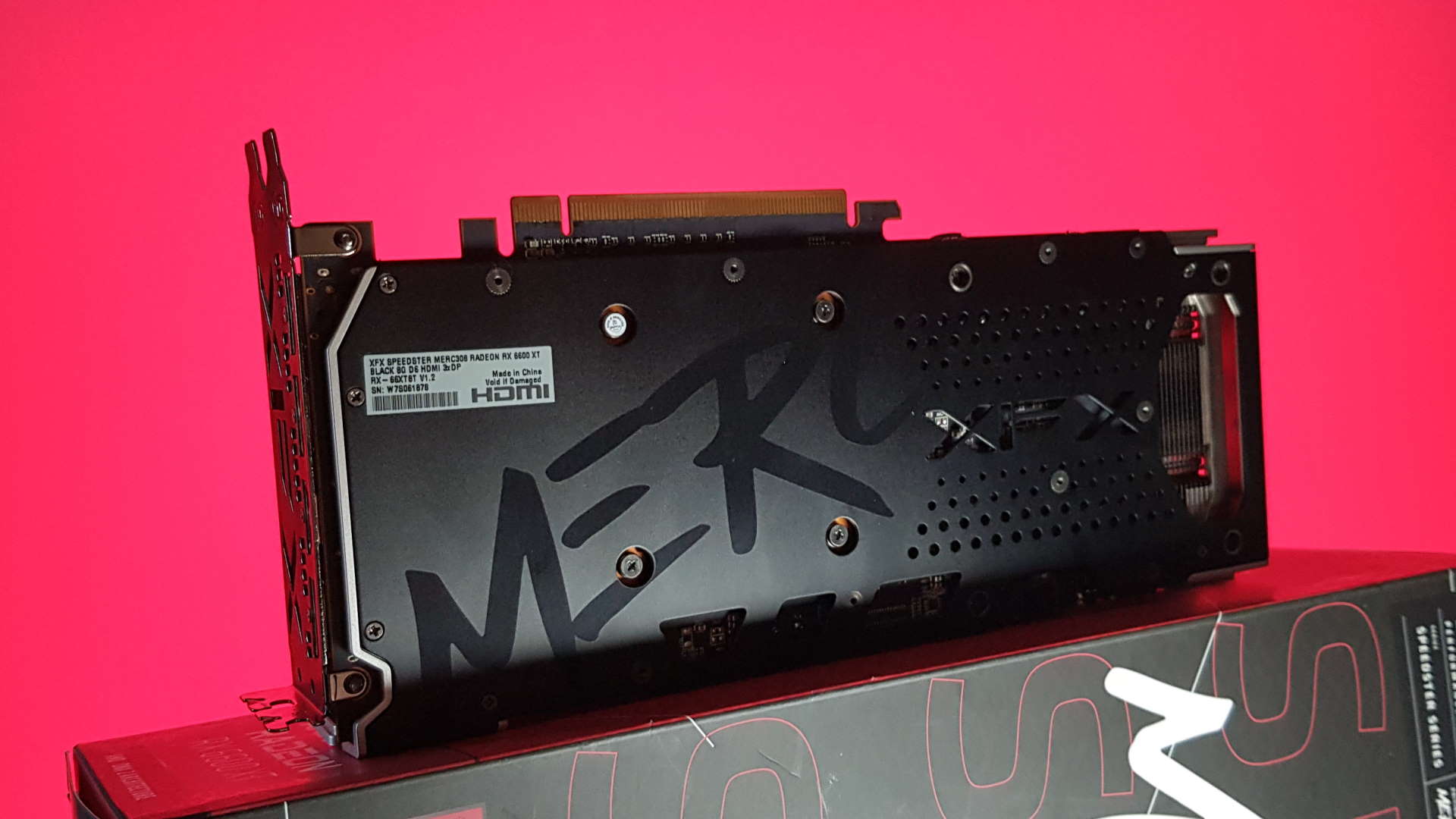
With that it's also worth noting that, like with the Nvidia RTX 3060, you won't find reference model versions of AMD's latest GPU. That's why we've got the XFX card here, rather than the sort of pleasingly chonky black and grey reference numbers we've had for the Radeon RX 6700 XT et al.
But the Navi GPU silicon itself isn't the whole deal with AMD's latest cards, the memory subsystem is absolutely key, especially down at this end of the stack. Compared with the rest of the RX 6000-series cards that have already been released, and the last-gen RX 5000-series, we're looking at a memory bus usually reserved for cards lower down the ladder.
With 8GB of 16Gbps GDDR6 arrayed across an aggregate 128-bit bus you'd normally expect the GPU to be starved of memory bandwidth, and while it's certainly lower than either the 448GB/s of the RX 5700 XT or the 288GB/s of the RX 5600 XT, its 256GB/s figure doesn't look too bad.
But that's without taking into account the RDNA 2 magic bullet of Infinity Cache. This is a supplementary, die-mounted slice of speedy cache memory, that will intercept a bunch of calls that would otherwise have to go across the PCIe bus to memory pools outside of the card itself. With something like the RX 6800 XT, and its healthy chunk of 128MB of Infinity Cache, and an already high memory bandwidth, this extra cache is partly responsible for its 4K performance.

With the RX 6600 XT, however, Infinity Cache ought to be arguably more important. AMD said, when it introduced the new RDNA 2 design, that cache hits are most likely at 1080p, though at that resolution you're less likely to run into issues with memory bandwidth on higher-spec card. The RX 6600 XT, however, is already pretty restricted in terms of bandwidth, and so the regularity of cache hits at its target resolution should mean the extra effective bandwidth boost of Infinity Cache will be a true boon for its limited 128-bit bus.
Though that's tempered by the fact there is only a rather paltry 32MB of this performance-salving cache available to the latest AMD card, however.
And then there's ray tracing. Which, let's be honest, you don't really care about if you're buying an AMD graphics card.
AMD Radeon RX 6600 XT performance
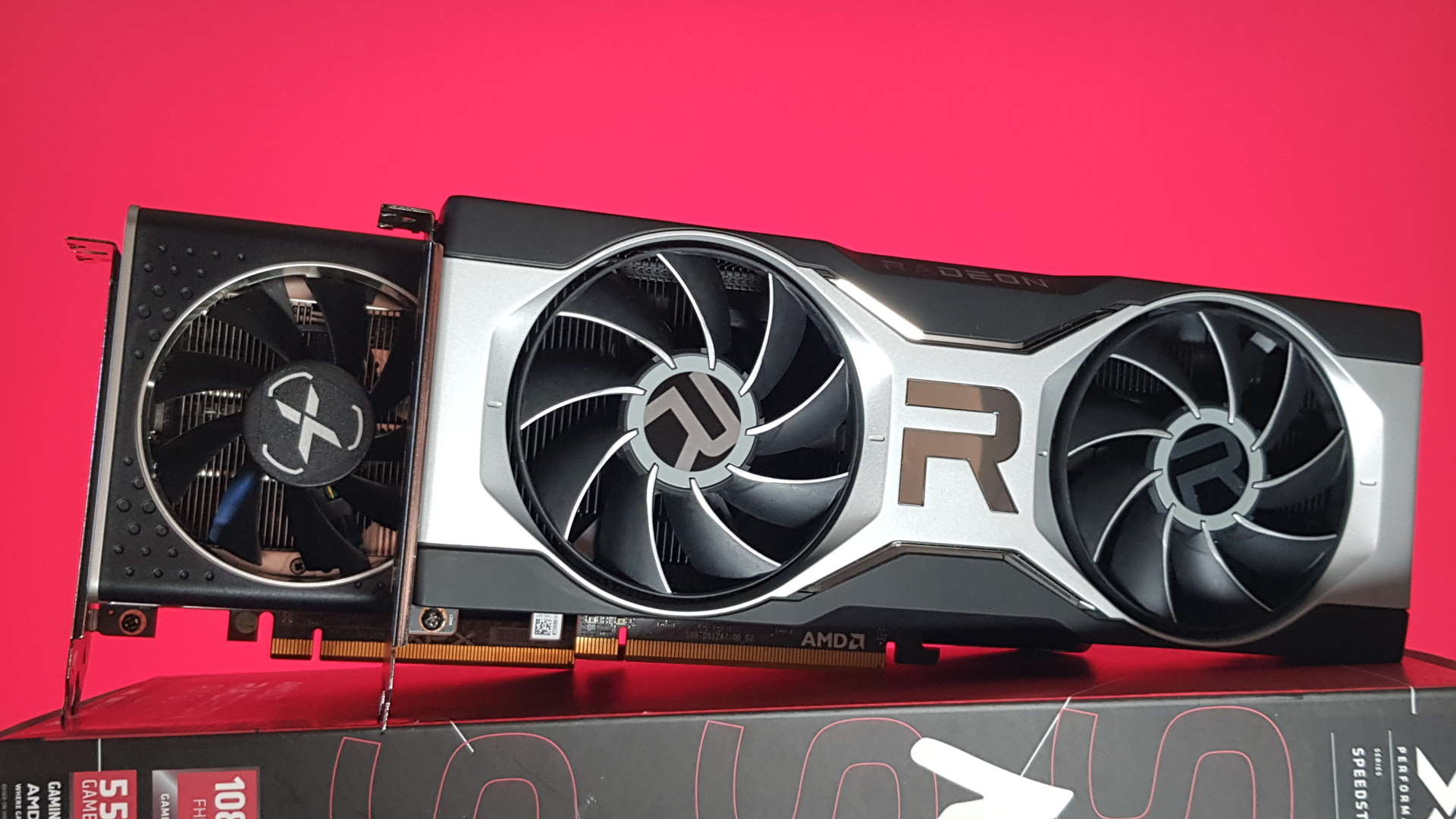
How does the Radeon RX 6600 XT perform?
There are no real surprises here, which itself isn't much of a surprise.
The further you get into a new architectural generation of graphics card the more it becomes a known quantity and you can almost predict the performance ballpark of subsequent iterations of GPU. When looking at relative 3DMark Time Spy Extreme GPU numbers—flatter line from RX 6900 XT to RX 6800 XT aside—the trend is almost completely linear through the rest of the four Radeon cards.
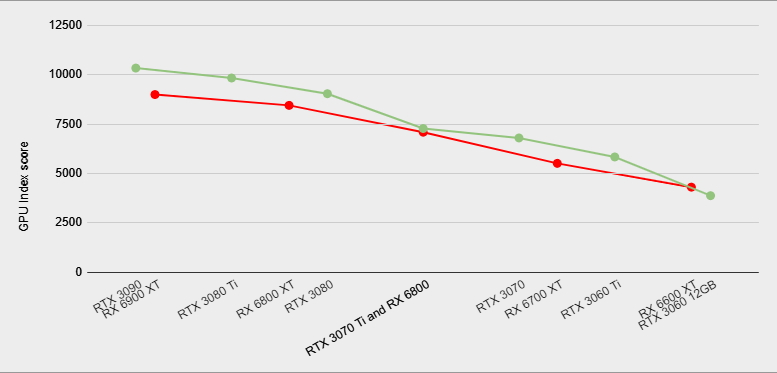
There is a lot more variation, for good or ill, when you look at the green line of GeForce 3DMark scores.
For the RX 6600 XT itself, the good news is that it confidently beats Nvidia's cheapest Ampere GPU, the RTX 3060, across the board. That was a card we were initially keen on around launch, but its lustre is maybe wearing off. Still, it's the most affordable 'next-gen' GPU right now, which is at least something.
On the other hand, the RX 6600 XT falls short of the pace of the GeForce RTX 3060 Ti, which is looking ever more like the card of this current generation.
AMD RX 6600 XT 1080p gaming performance
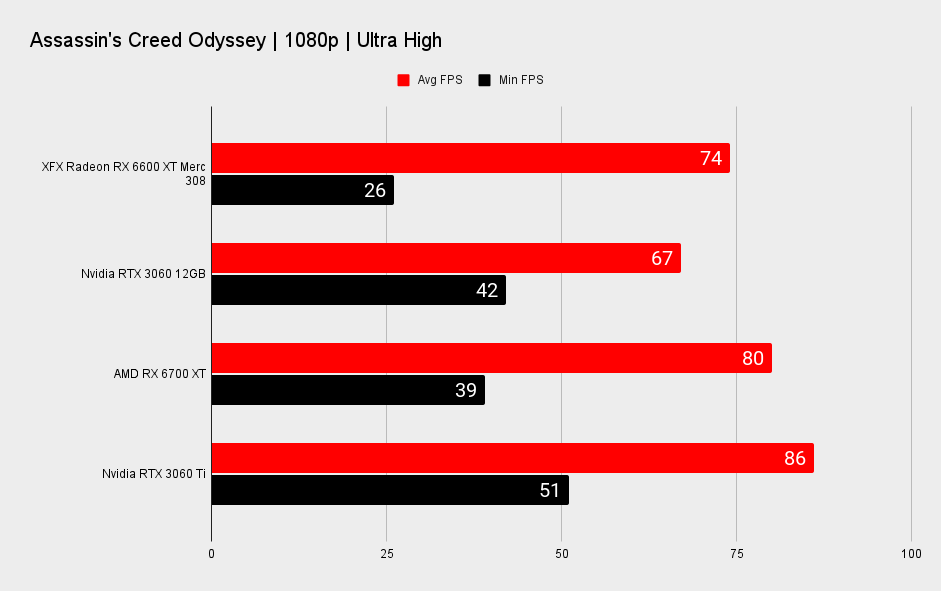
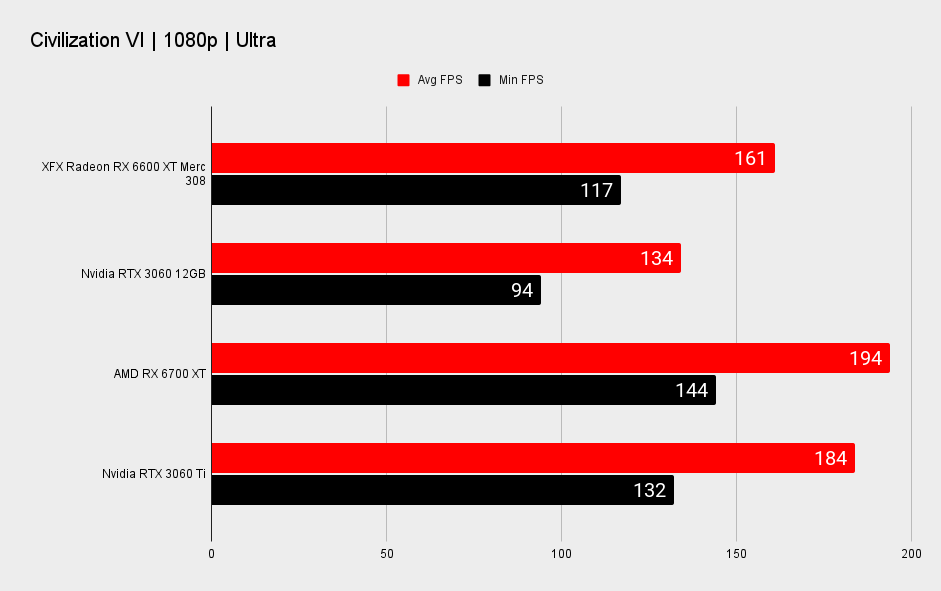
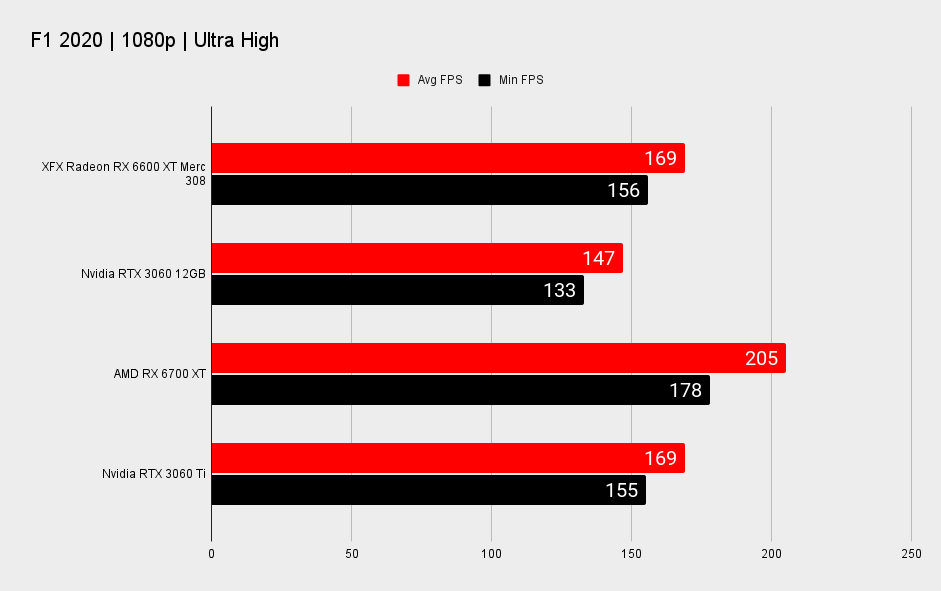
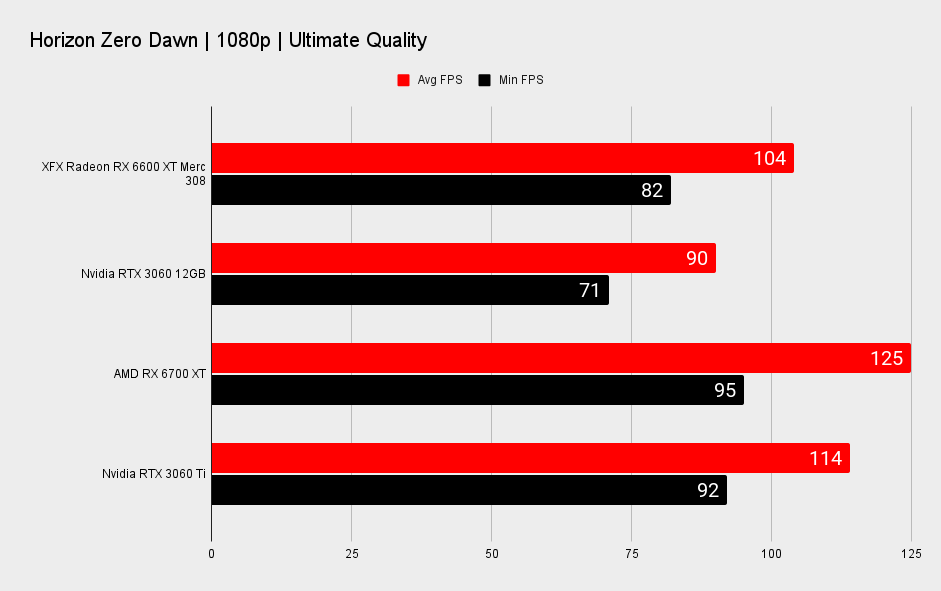
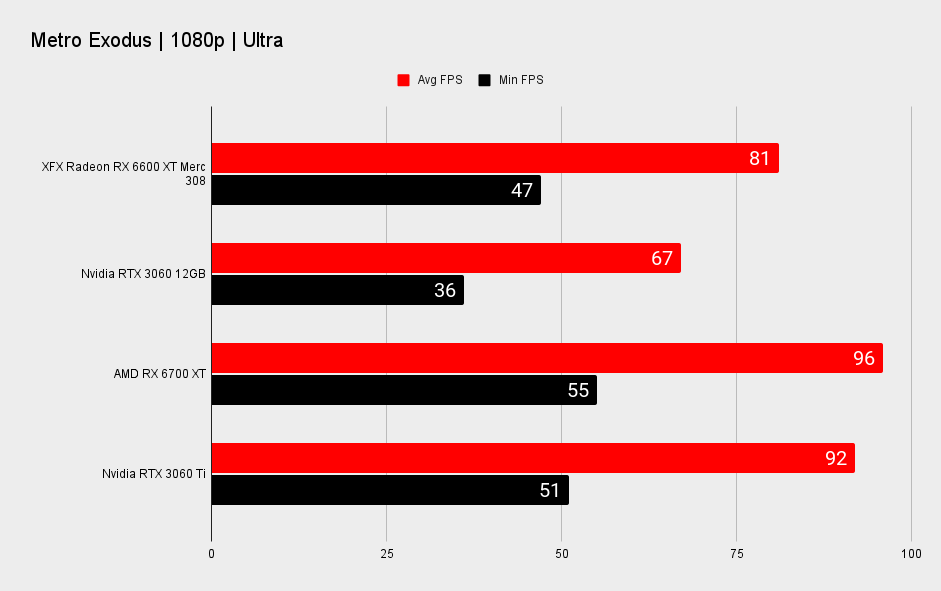

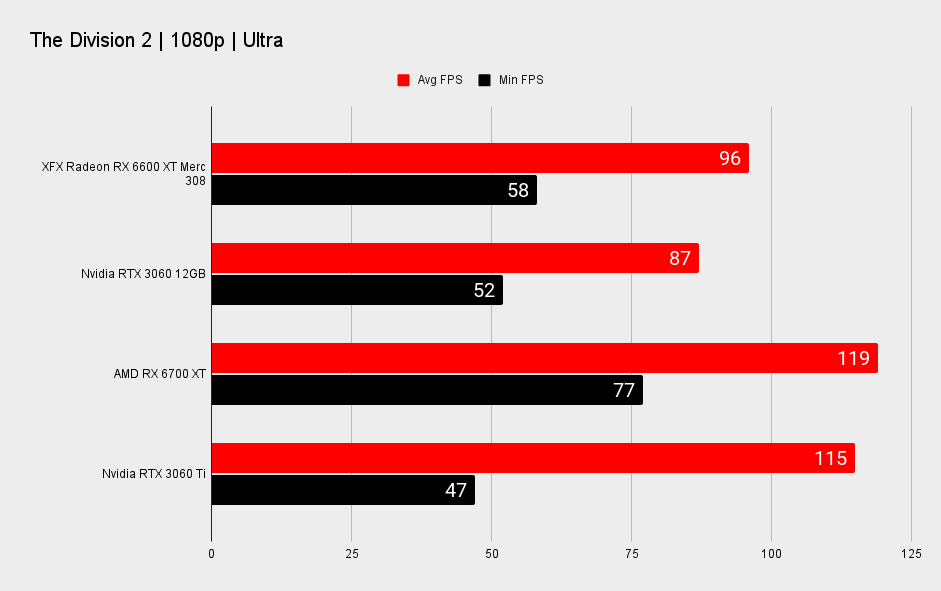
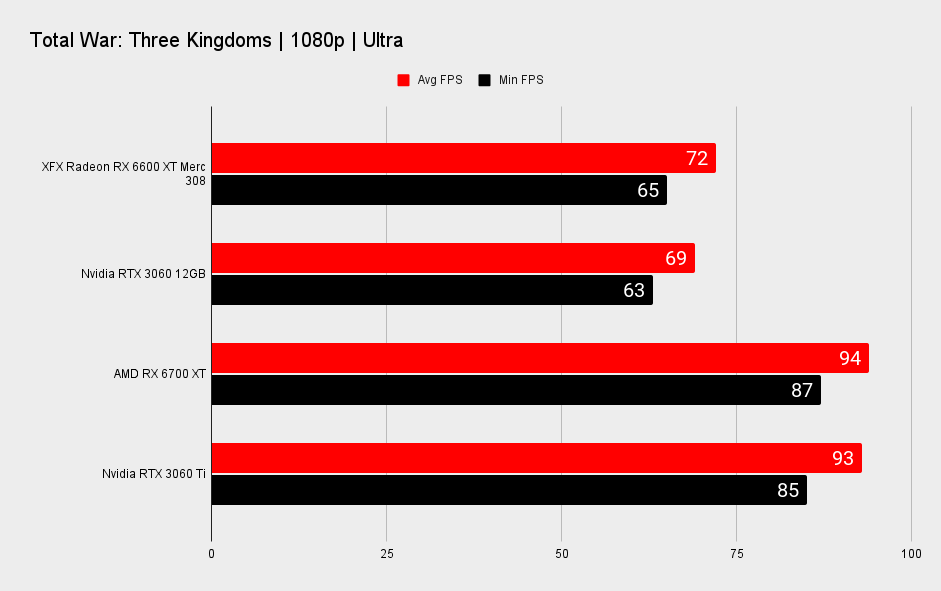
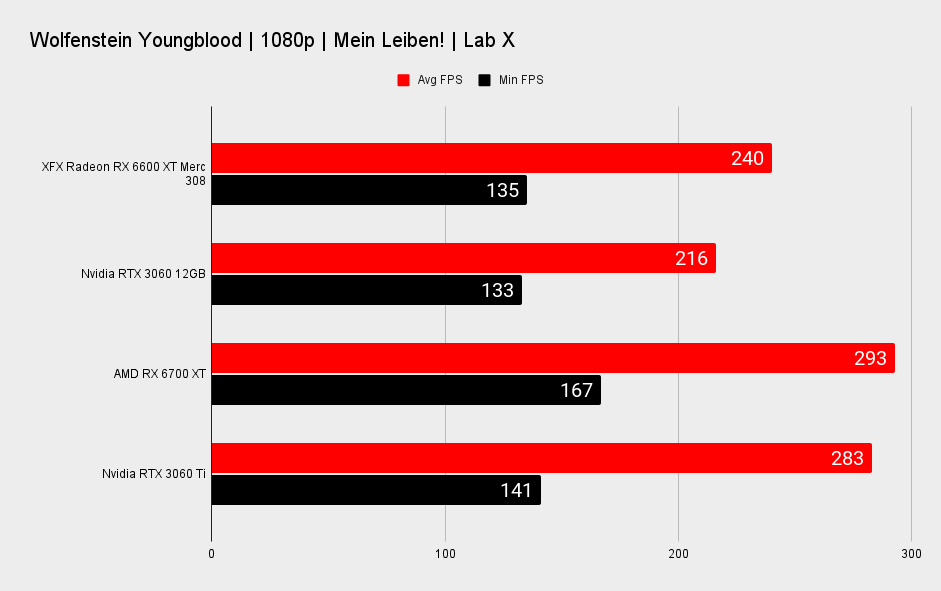
The best showing for the newest Navi GPU is at its 1080p target resolution. That's generally been the case for AMD's cards compared to their Nvidia competition this time around. With the RX 6600 XT it's some 15% slower on average than the nominally $20 more expensive Nvidia card at this res, though that performance delta quickly grows you shift gears to 1440p and then on to 4K.
If you're sporting a higher resolution monitor, or just want to get yourself those high 1080p frame rates in competitive shooters that AMD seems to be aiming its new card, then that $20 outlay starts to look increasingly like money well spent on the RTX 3060 Ti.
AMD RX 6600 XT 1440p gaming performance


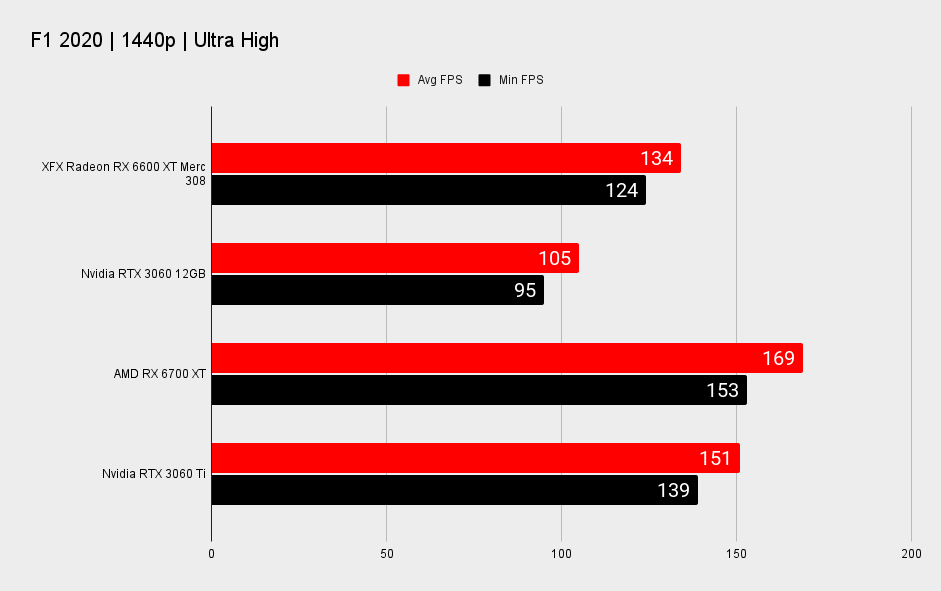
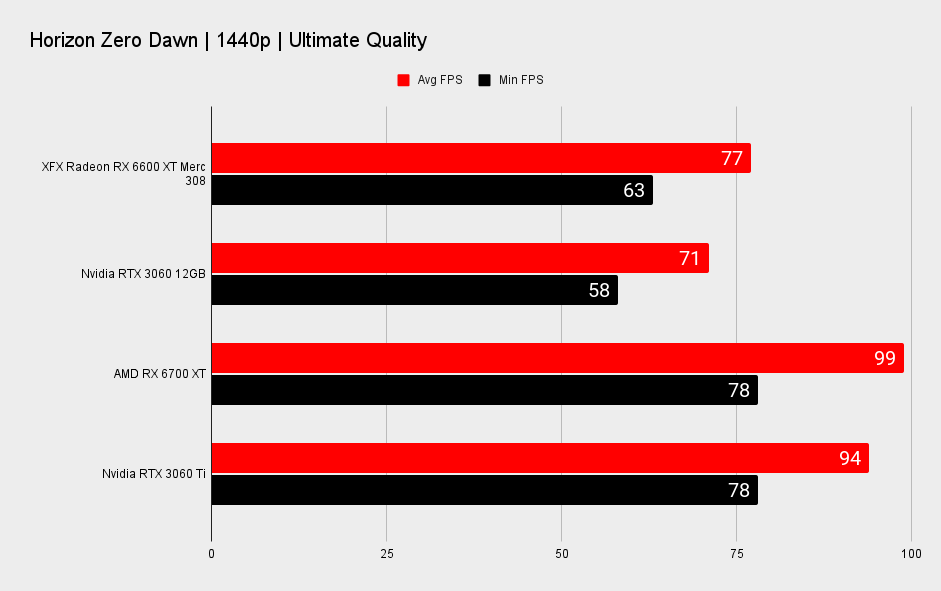
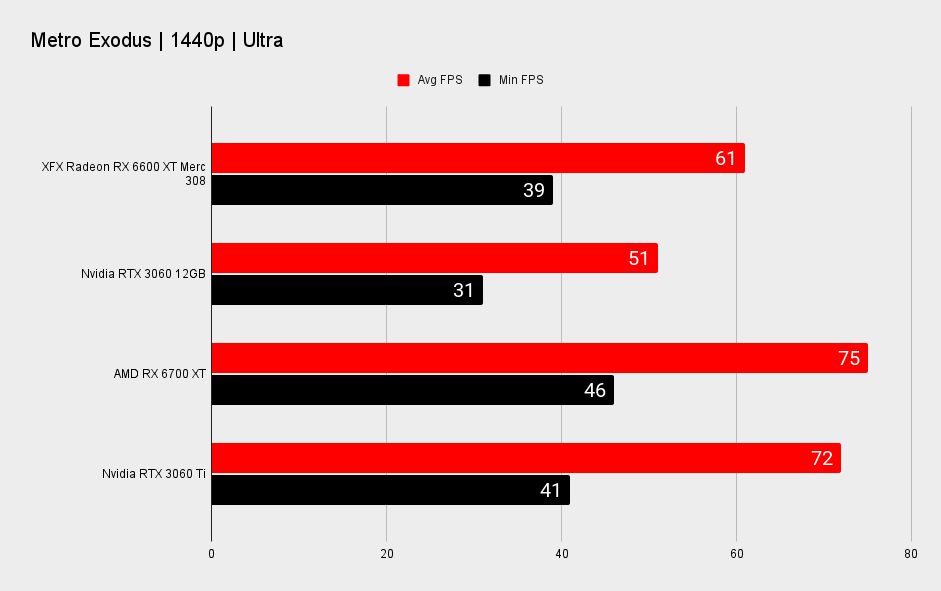

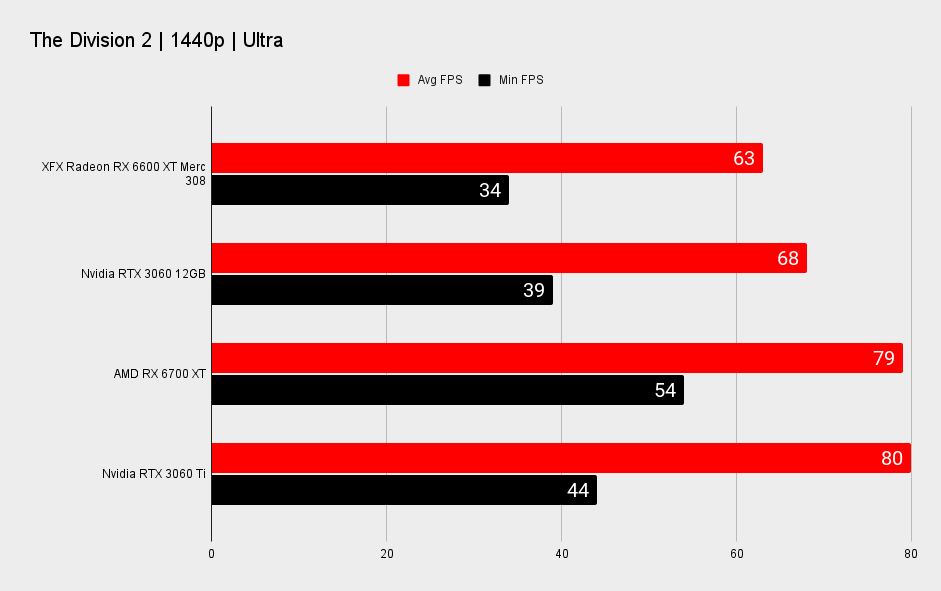

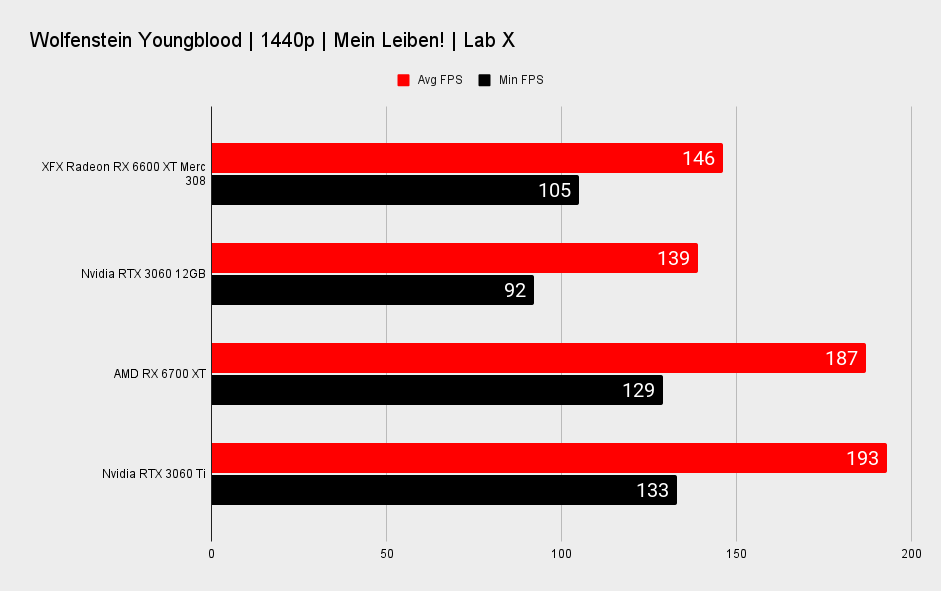
AMD RX 6600 XT 4K gaming performance


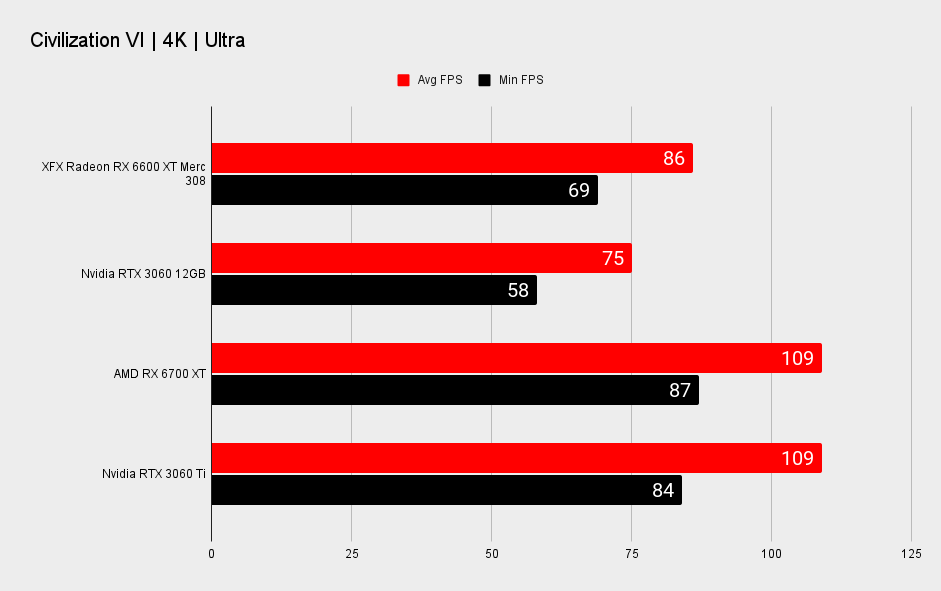


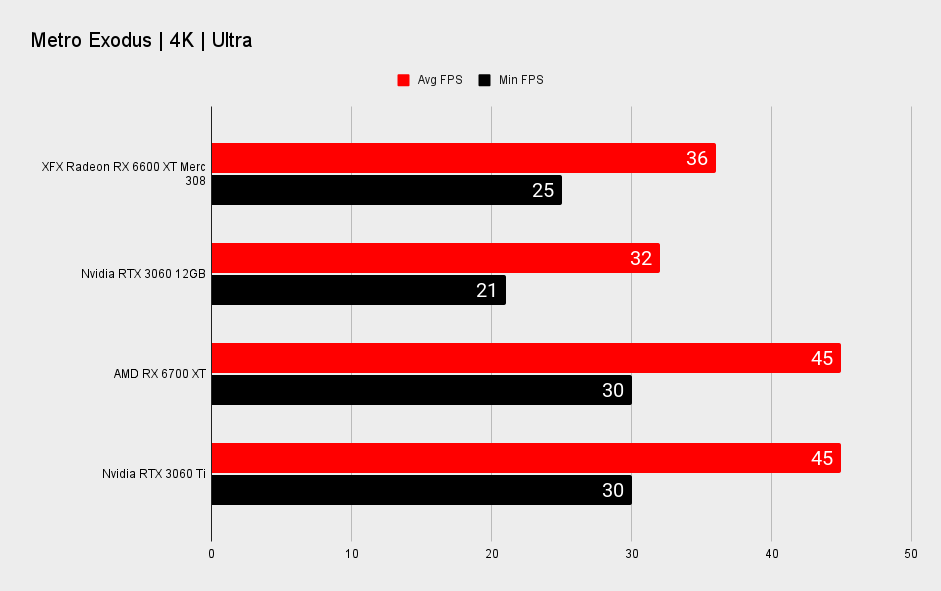

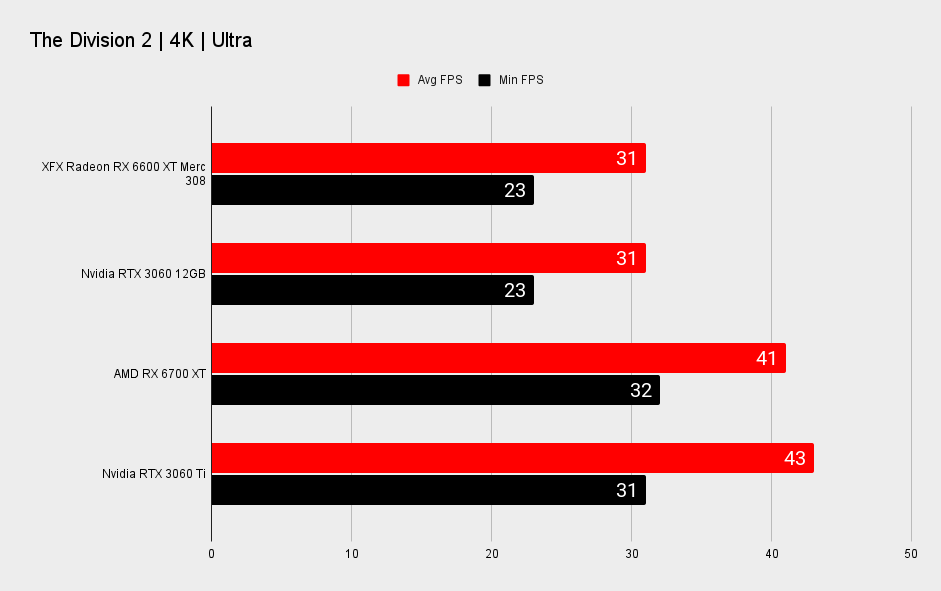

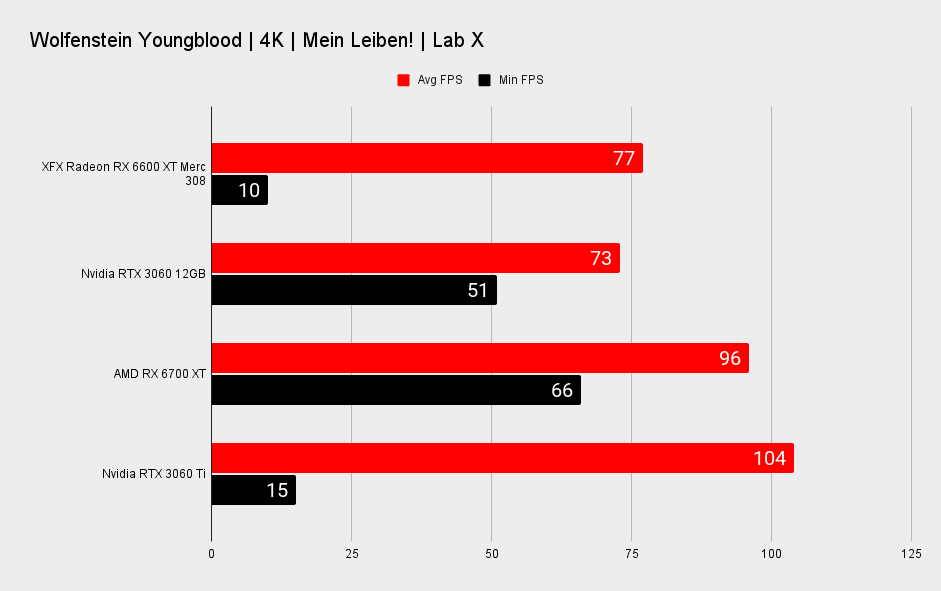
AMD RX 6600 XT ray tracing performance
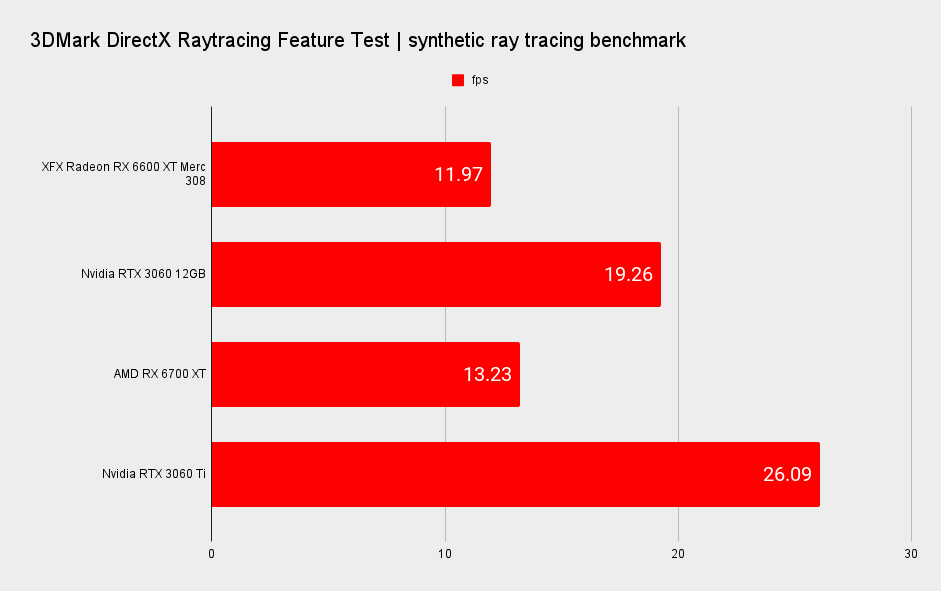

CPU - Intel Core i7 10700K
Motherboard - MSI MPG Z490 Gaming Carbon WiFi
RAM - Corsair Vengeance RGB Pro @ 3,200MHz
CPU cooler - Corsair H100i RGB Pro XT
PSU - NZXT 850W
Chassis - DimasTech Mini V2
Monitor - Eve Spectrum
The efficient GPU at the heart of the RX 6600 XT, coupled with the impressive triple fan cooler offered by XFX's Merc 308 edition, means that this review card remains super chill even under sustained load. To be fair, it's not like RTX 3060 Ti with its Founders Edition shroud is particularly toasty, but even when cranking up the clock speed of the RX 6600 XT it never broke the 70°C mark, which is supremely impressive.
In terms of power, too, the RDNA 2 architecture shows its class. Despite regularly outshining the RTX 3060 in terms of raw gaming performance it also does so with both a significantly lower average power draw and lower peak too.
AMD RX 6600 XT power and thermals
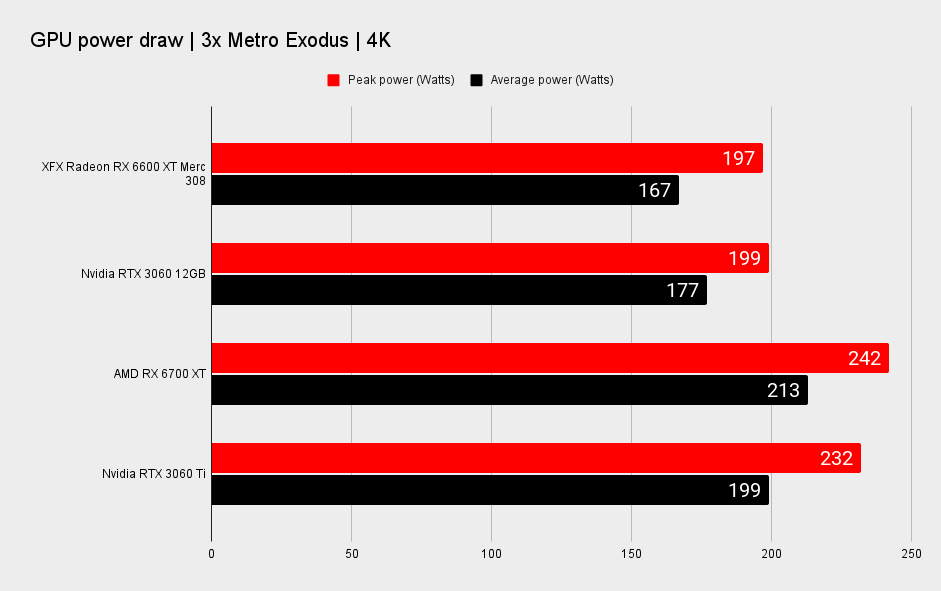
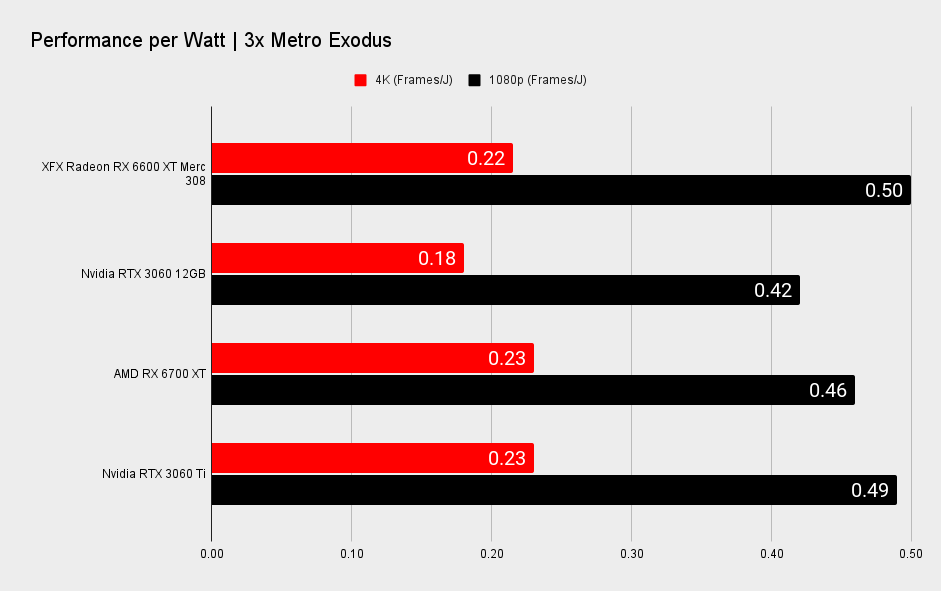

AMD Radeon RX 6600 XT analysis
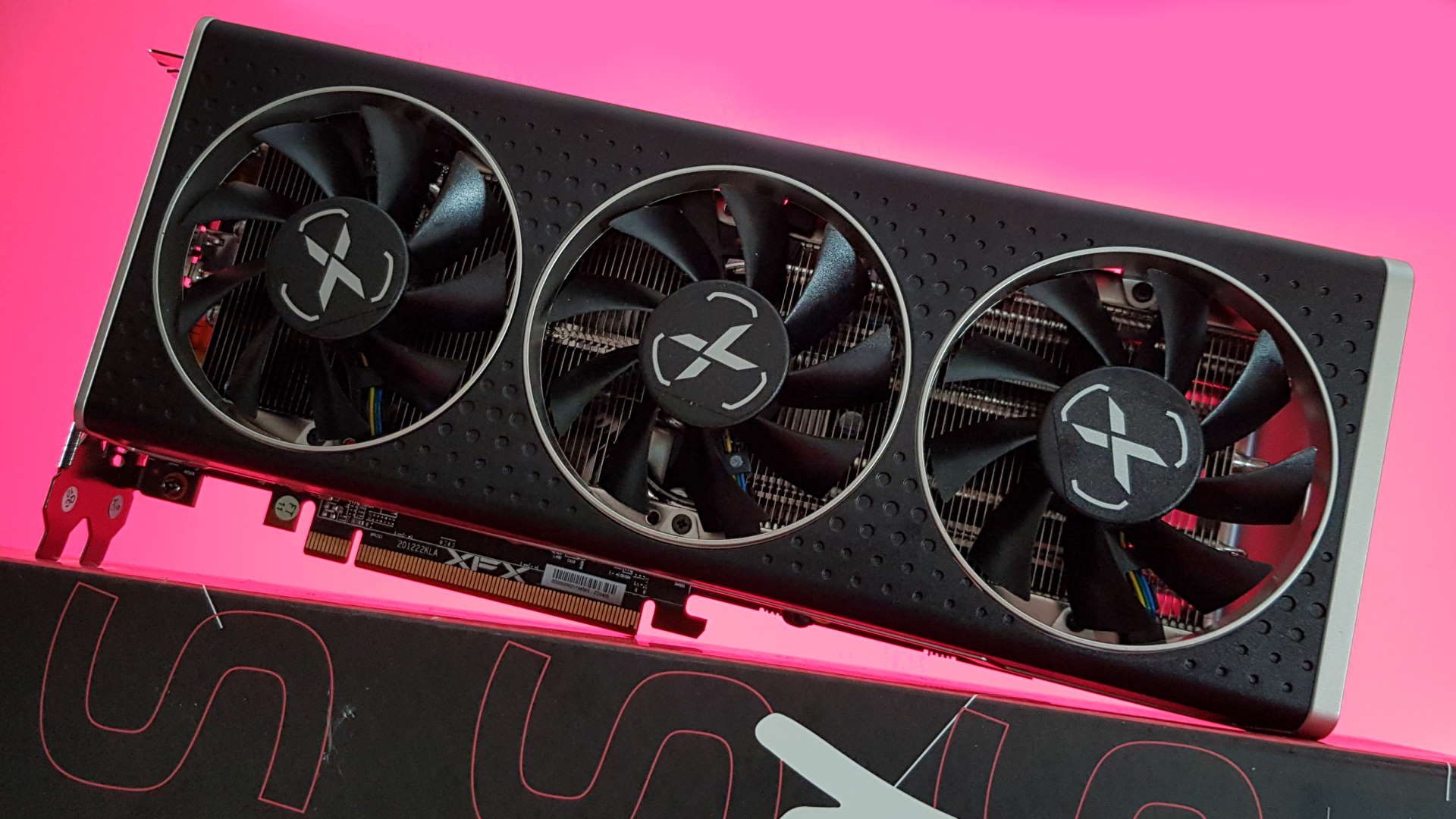
How does the Radeon RX 6600 XT stack up?
For most of this GPU generation, and for a significant part of the last, the regular refrain has been that raw performance numbers are one thing, but Nvidia has a serious edge in terms of the extra features. While real-time ray tracing has been touted as the biggest, realistically it's the almost-indistinguishable-from-magic Deep Learning Super Sampling (DLSS) tech that has garnered more industry plaudits.
Delivering higher gaming performance with a barely perceptible impact on visual fidelity has long been something Nvidia is rightly proud of. And it's been something that has regularly been the differentiating factor between recommending an Nvidia card over an AMD one.
But AMD now has a pool of features with its recent Radeon cards that, while they maybe can't quite match up to their GeForce equivalents, provide a genuine value-add on top of the base frame rate levels of its GPUs. King of those is FidelityFX Super Resolution (FSR). It is held up as AMD's answer to DLSS, though it is a very different thing, it can help you get higher frame rates in select games, without being particularly punitive when it comes to the look of your game.
We're big fans of it, and while it's not as snazzy a solution as DLSS, it will still deliver more performance and look pretty great while doing so. That's a definite win for a mid-range card such as the RX 6600 XT.
Though FSR looks a little underrepresented when it comes to game support, AMD's promise that it's easy for devs to implement has been born out by earnest modders dropping FSR the feature into different games, such as GTA V and Skyrim VR, themselves. Some have even created apps that allow you to add it into practically any Windows or Vulkan game.
Then there's Radeon Anti-Lag and Radeon Boost, now with a variable rate shading boost in certain titles, which are both designed to deliver the slickest gaming performance in competitive games where milliseconds can be the difference between life and death.
And the Adrenalin driver software isn't so awkward to use anymore either. The drivers themselves have been regularly improving over the years, but that actual software is now joining it. Obviously there are some issues, like strange hardware recommendations, and settings being buried and needlessly obfuscated inside Russian doll menus, but it feels far more solid than it has in a while.

But this improved AMD package doesn't change the fact that I'd happily pay the extra $20 that would theoretically get me the more performant Nvidia RTX 3060 Ti over the AMD RX 6600 XT. In raw performance terms it's the quicker GPU, and then you can add the green team's own impressive feature set on top of that.
Which makes the pricing of this card my biggest frustration. At $379 it's obviously far too expensive for what it is, and what it represents. But AMD has been laser-focused on boosting the average selling price of its components, and the GPU shortage has now given it ample opportunity to do so with its Radeon graphics cards.
There was a real chance here to stick it to Nvidia and either match or beat the price of the RTX 3060, in which case we'd be only mentioning the relative power of the RTX 3060 Ti card in passing, not focusing on it. What makes that doubly frustrating is that, with few RX 6600 XT cards ever likely to be sold at the MSRP, AMD could just as easily have plucked a cheaper price out of the air and basked in the goodwill that generated. Instead it's looking overpriced up against the only slightly more expensive, and faster Nvidia GPU.
It's also not like the RX 6600 XT is really moving things along any either. It's practically the same price as the RX 5700 XT, and only single digit figures faster on average. Taking our entire benchmarking suite into account, this new card delivers average 1080p frame rates only 7% higher than the first-gen Navi card, while only being 5% cheaper than the RX 5700 XT's $399 MSRP.
The new GPU is more efficient, with significantly lower power consumption, and definitely a more technically elegant solution, though that doesn't make a huge difference in terms of actual temperatures or performance. I can absolutely say the RDNA 2 architecture is certainly a better technology than its RDNA 1 forebear, but the in-game results in this case are barely any different.
Though if I just say the fifth tier of this latest generation of AMD graphics cards effectively matches the frame rate performance of the best of the previous generation, then things look pretty rosy. But when you consider they're both the same price that doesn't really feel like a lot of mainstream progress to me.
Remember when there were great $250 graphics cards in every generation? Seems like a long time ago now. And with the GPU shortage expected to last for at least another year, it seems like a long way to go from where we are now, too. Neither AMD or Nvidia are likely to dip their toes into that traditionally high-volume mainstream level when every higher-priced graphics card is being sold anyway.
Why supply cheaper cards, when the thirst forsimply anything is so insatiable?
AMD Radeon RX 6600 XT verdict
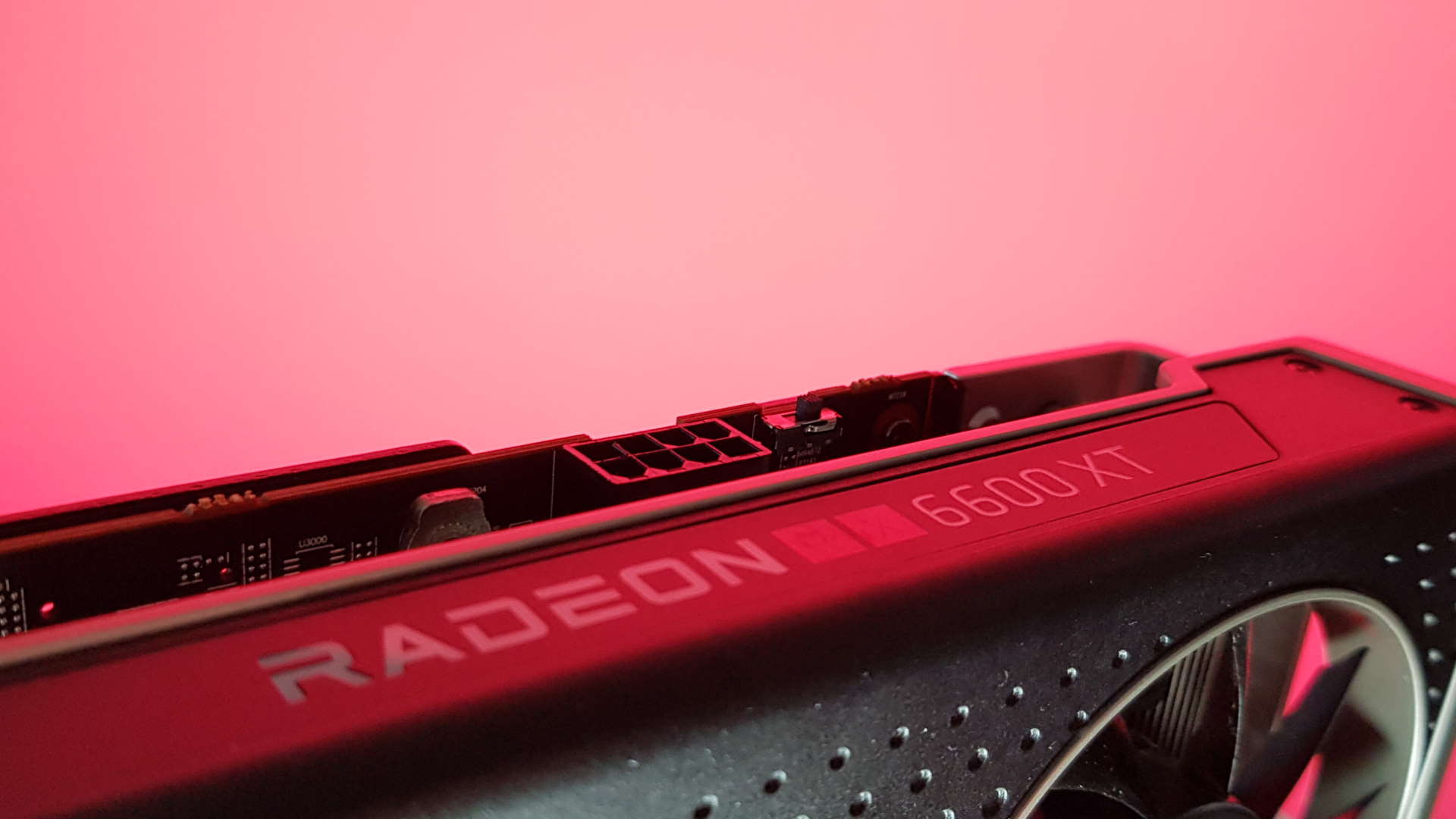
Should you buy the Radeon RX 6600 XT?
The new AMD RX 6600 XT is a graphics card in 2021, which means two things: It's MSRP will be ephemeral at best, and every single one manufactured will be sold anyway. Quickly.
When it comes to gaming performance the RX 6600 XT is an excellent 1080p GPU, just as the RX 5700 XT was, and honestly like any near-$400 graphics card has been in any generation of the last five years. Really that should be a given, and we should at least be looking to push high refresh rate monitors at 1440p when we're spending this much cash on a GPU.
It comfortably beats the RTX 3060, which I guess is the point, but it's nominally $50 more. Though it's pretty well off the pace compared with the RTX 3060 Ti which costs only another $20. With that card's higher resolution performance, the magic of DLSS, and Nvidia's generally greater availability, that's where my recommendation lies right now.
The positioning and pricing of the RX 6600 XT seems out of touch with the rest of the GPU market. But that's when we're talking about relative MSRP's, which, in the current silicon-starved state of the industry, are almost utterly irrelevant.
At any other time there would be some last-gen cards still floating around in retail, and if there were any RX 5700 XTs still out there priced normally the RX 6600 XT would have a very different launch price. But, in this darkest timeline, there aren't.
And that's why AMD can price its new card so high, and still be confident that it'll sell out almost immediately.
In an alternate universe, without the current silicon drought, AMD's RX 6600 XT is less than $300 and a great mid-range option. In this, the darkest timeline, it's almost $400, negligibly quicker than an RX 5700 XT and only slightly cheaper. Though at least it's better than the RTX 3060.

Dave has been gaming since the days of Zaxxon and Lady Bug on the Colecovision, and code books for the Commodore Vic 20 (Death Race 2000!). He built his first gaming PC at the tender age of 16, and finally finished bug-fixing the Cyrix-based system around a year later. When he dropped it out of the window. He first started writing for Official PlayStation Magazine and Xbox World many decades ago, then moved onto PC Format full-time, then PC Gamer, TechRadar, and T3 among others. Now he's back, writing about the nightmarish graphics card market, CPUs with more cores than sense, gaming laptops hotter than the sun, and SSDs more capacious than a Cybertruck.


